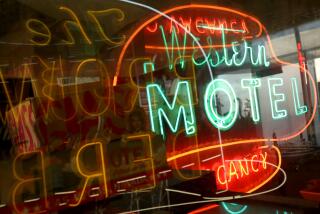Shedding Light on the History of Neon
- Share via
Question: I have a pretty good collection of neon signs. How far back do they go in the American culture scene so I can gauge their value?--C.I.
Answer: For openers, as is the case with many other collectibles, age is not necessarily the bottom line when it comes to determining value.
In any case, neon signs first appeared in the United States in the mid-1920s. The story--and we don’t think it’s apocryphal--is that a Packard dealer is believed to have been the first American to spot the consumer value of the neon sign while traveling in France. The auto dealer immediately sensed their promotional worth, snapped two of them up and brought them back to Los Angeles.
As the story goes, the signs created huge traffic jams and, presumably, lots of business for the auto dealer.
Neon collectors like to go for symbols, say dealers and others who are always searching for new additions to their neon collections. A beer bottle sign from a tavern or a fish sign to attract attention to a fish market are popular.
Neon began fading in the 1960s as technology began overtaking even the advertising-sign market. But the nostalgia kick of the last decade has once again made them popular among collectors who have been scouring industrial inventories for old signs. At the same time, prices for these signs have risen sharply in recent years.
Needless to say, condition is important, and most collectors would want a neon sign that is working--something to keep in mind if you’re bargaining at a country store or flea market.
Q: I collect Bibles. Much has been written about the Gutenberg Bible, of course, but I understand that there is one called the Aitken Bible, which is also of great value to collectors.--C.A.
A: The Aitken Bible is of enormous significance and, hence, is quite valuable. It’s believed that this was the first Bible published in this country in English, printed in Philadelphia in the early 1780s.
Bible collecting takes a great deal of expertise. Just concentrating on American Bibles published over the past 200 years would mean that the dedicated collector would have to have some knowledge of hundreds of different printers and their versions of the book. In fact, it’s estimated that more than 2,000 different versions of the Bible have been published in this country in the past two centuries.
One attraction for the collector of the American version of the Bible is that American publishers often made liberal use of illustrations, such as woodcuts or engravings, which were either copies of European religious paintings and drawings or wholly new concepts created by American artists.
Dealers say Bibles dating back to the 19th Century can still be found for relatively modest prices. But, of course, Bibles in the Aitken league cost plenty.
Q: What are some good sources for old auto literature? I collect books, magazine articles, artwork and anything else I can lay my hands on.--R.E.
A: Then you no doubt search old magazines for auto art in the form of advertising and any drawings that might accompany articles. Additionally, old car catalogues have for years been sought by collectors like yourself who are interested in authentic drawings and pictures of the forerunners of today’s lighter, faster models. These catalogues were particularly popular at auto shows but were usually discarded and so are hard to find these days.
If you’ve frequented bookstores or flea markets, you’ve probably noticed such catalogues taking off in price in recent years. Now, it’s not unusual for an aging auto catalogue to bring more than $100 when it changes hands--if it’s in good condition.
And don’t forget the auto manufacturers themselves who publish handbooks on their models. These too have taken off in price--particularly those produced before World War I.


